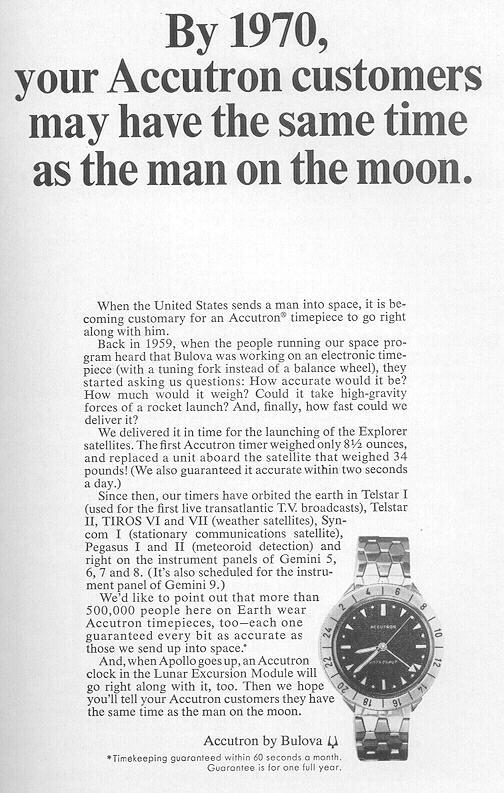
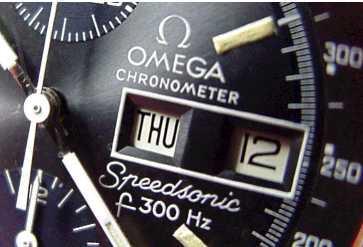
| The Speedsonic is interesting for several reasons. Firstly, it has a hybrid electronic/mechanical tuning fork movement based on the Bulova Accutron design. The incorporation of this movement into the Speedmaster range was a radical departure from the trusty calibre 321 and 861 (manual wind) or 1040 (automatic) mechanical movements hitherto used. Given the importance Omega placed on the NASA accreditation it had received for the Speedmaster after rigorous testing for space flight, why would it now use a movement produced under licence from its fiercest rival for that accreditation? (Bulova tried everything to get its candidate watch (a mechanical chronograph using a Swiss 17-jewel movement supplied by Universal Genève, Bulova's subsidiary in Switzerland) accepted for the space program, including offering to supply them at no cost to NASA. They even tried to apply political pressure by invoking the Buy American Act, which in fact nearly rebounded on them. It was only by including research and development costs that Bulova's own watch met the Act's minimum requirements for an item to be considered as a domestic source end product.) Bulova already had its products on satellites and space craft consoles as timers, but they desperately wanted the publicity that would flow from having the first man on the moon actually wearing a Bulova watch. |  |
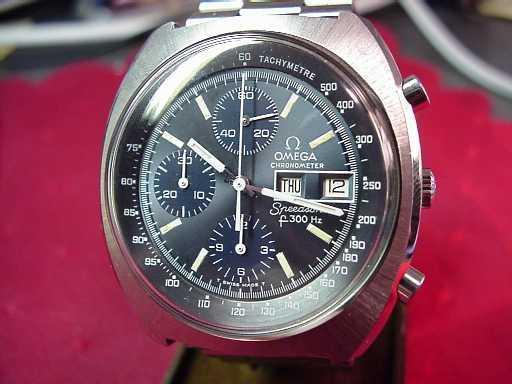 The first thing that struck me was how incredibly large and heavy it was. It felt (and looked) like a square billet of solid stainless steel, but with the mass of gold (I wish!). By comparison the bracelet felt quite light, although it looked solidly made. The dial was satin finished in charcoal grey, with contrasting matt black subdials. All hands and markings were stark white, apart from the hour markers which had that slightly yellow vintage-tritium-almost-past-its-use-by-date look. It had a tachymetre scale running around the dial like the normal Speedie Pro, but under the massive hesalite crystal instead of exposed on the bezel (similar to the Speedie MkII, III and IV. Hesalite is a very strong, very clear acrylic known as "armoured glass".) Overall the dial was not quite as legible as the Moon Watch Speedmaster, being a little more crowded, but it was still very good in the readability department. I held it up to my ear. I heard a faint low hum from the vibrating fork (at 300 Hz, of course), and if I listened very carefully, I could also hear an even fainter high-pitched whine. I didn't know it then, but this latter noise was the sound of the click blades pushing on the teeth of the index wheel at the rate of 300 pushes per second. The rest of the gear train hangs off the index wheel.
The first thing that struck me was how incredibly large and heavy it was. It felt (and looked) like a square billet of solid stainless steel, but with the mass of gold (I wish!). By comparison the bracelet felt quite light, although it looked solidly made. The dial was satin finished in charcoal grey, with contrasting matt black subdials. All hands and markings were stark white, apart from the hour markers which had that slightly yellow vintage-tritium-almost-past-its-use-by-date look. It had a tachymetre scale running around the dial like the normal Speedie Pro, but under the massive hesalite crystal instead of exposed on the bezel (similar to the Speedie MkII, III and IV. Hesalite is a very strong, very clear acrylic known as "armoured glass".) Overall the dial was not quite as legible as the Moon Watch Speedmaster, being a little more crowded, but it was still very good in the readability department. I held it up to my ear. I heard a faint low hum from the vibrating fork (at 300 Hz, of course), and if I listened very carefully, I could also hear an even fainter high-pitched whine. I didn't know it then, but this latter noise was the sound of the click blades pushing on the teeth of the index wheel at the rate of 300 pushes per second. The rest of the gear train hangs off the index wheel.
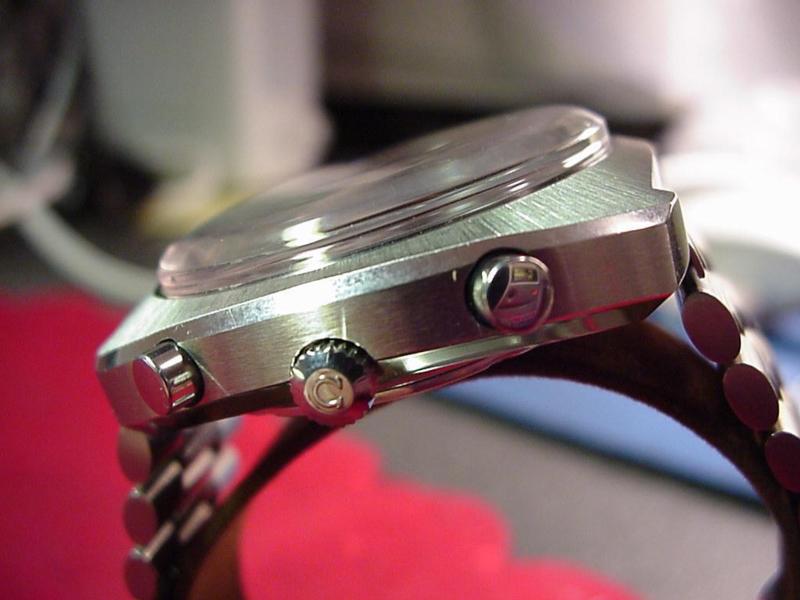 FOR THE FIRST DAY OR SO it felt like I had a bar fridge strapped to my arm. During the 70s it appeared for all the world as if Omega were trying to design the heaviest, squarest and thickest watch cases ever made, and with the Speedsonic I think they very nearly succeeded. On the kitchen scales it weighs in at 150 grams (5.3 oz) complete with bracelet; from front to back it measures 15mm (19/32"). The band needs to be adjusted fairly tight to stop the watch from going into orbit around your wrist. In time one gets used to it and other watches feel ridiculously lightweight. The rounded corners of the tonneau case help prevent it catching on shirt cuffs, and to my eye the dial design is restrained enough for it to be worn with a business suit. A night at the opera would demand something more elegant to complement the tuxedo.
FOR THE FIRST DAY OR SO it felt like I had a bar fridge strapped to my arm. During the 70s it appeared for all the world as if Omega were trying to design the heaviest, squarest and thickest watch cases ever made, and with the Speedsonic I think they very nearly succeeded. On the kitchen scales it weighs in at 150 grams (5.3 oz) complete with bracelet; from front to back it measures 15mm (19/32"). The band needs to be adjusted fairly tight to stop the watch from going into orbit around your wrist. In time one gets used to it and other watches feel ridiculously lightweight. The rounded corners of the tonneau case help prevent it catching on shirt cuffs, and to my eye the dial design is restrained enough for it to be worn with a business suit. A night at the opera would demand something more elegant to complement the tuxedo.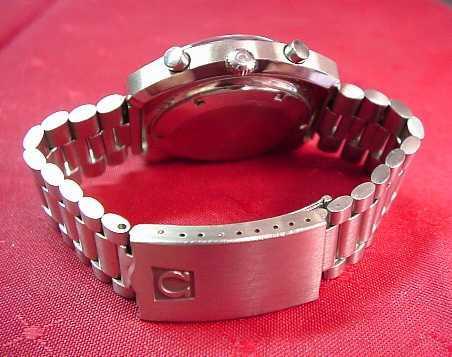
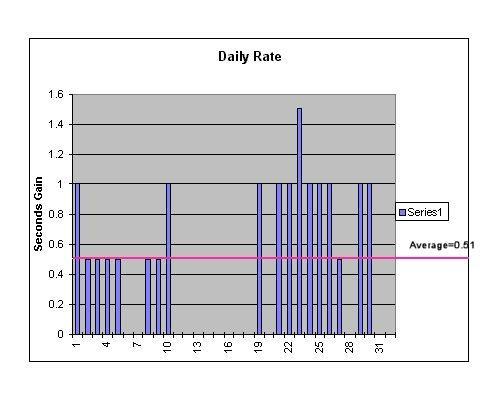
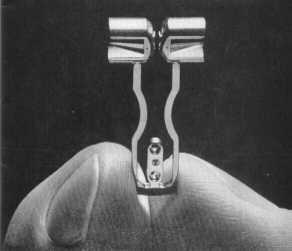 It's the movement that makes this watch special, and so it deserves a section to itself. The heart of the movement is of course this little fellow (right). Well, not exactly, because the Speedsonic uses a modified fork design with additional weights near the magnets. These give superior performance by reducing positional error to virtually zero. Another difference is that in the early design (below left), adjustment of the fork's natural frequency (and hence the timing) is accomplished by turning weights on the inward-facing ends of the fork cups. In the modified design (below right) this is accomplished by rotating the weights mounted on the bottom of the tines by equal amounts in opposite directions. Omega also claim that by repositioning the driving click near the bottom of the tuning fork, the effects of wear are minimised leading to longer correct functioning of the indexing mechanism.
It's the movement that makes this watch special, and so it deserves a section to itself. The heart of the movement is of course this little fellow (right). Well, not exactly, because the Speedsonic uses a modified fork design with additional weights near the magnets. These give superior performance by reducing positional error to virtually zero. Another difference is that in the early design (below left), adjustment of the fork's natural frequency (and hence the timing) is accomplished by turning weights on the inward-facing ends of the fork cups. In the modified design (below right) this is accomplished by rotating the weights mounted on the bottom of the tines by equal amounts in opposite directions. Omega also claim that by repositioning the driving click near the bottom of the tuning fork, the effects of wear are minimised leading to longer correct functioning of the indexing mechanism. 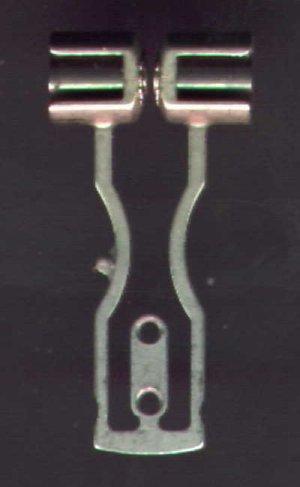
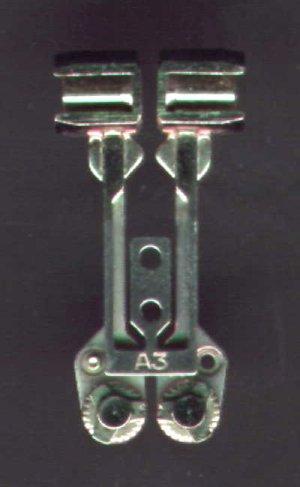
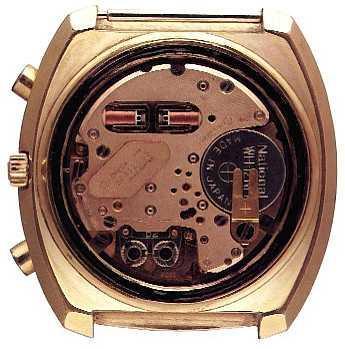 As you can see, the view after taking the back off a Speedsonic is not particularly exciting. The dominant feature is the battery, of which more later. The coils of copper wire forming the electromagnets are plainly seen, as are the poise-adjusting weights at the foot of the tines. The movement has 12 jewels, and is 'unadjusted'. It was made by the Swiss firm Ebauches SA (ESA) under licence to Bulova. These ESA movements use index wheels made by Bulova, and are probably the finest tuning fork movements ever made. They were certainly expensive to make. Omega sent their movements for COSC testing and so they received the 'Chronometer' certification. Exactly the same movement (part of the "Swissonic 100" series) was used for the Longines Ultronic and the Certina C-Tronic, among others. Only 21,000 of these movements were made, between 1972 and 1976.
As you can see, the view after taking the back off a Speedsonic is not particularly exciting. The dominant feature is the battery, of which more later. The coils of copper wire forming the electromagnets are plainly seen, as are the poise-adjusting weights at the foot of the tines. The movement has 12 jewels, and is 'unadjusted'. It was made by the Swiss firm Ebauches SA (ESA) under licence to Bulova. These ESA movements use index wheels made by Bulova, and are probably the finest tuning fork movements ever made. They were certainly expensive to make. Omega sent their movements for COSC testing and so they received the 'Chronometer' certification. Exactly the same movement (part of the "Swissonic 100" series) was used for the Longines Ultronic and the Certina C-Tronic, among others. Only 21,000 of these movements were made, between 1972 and 1976.